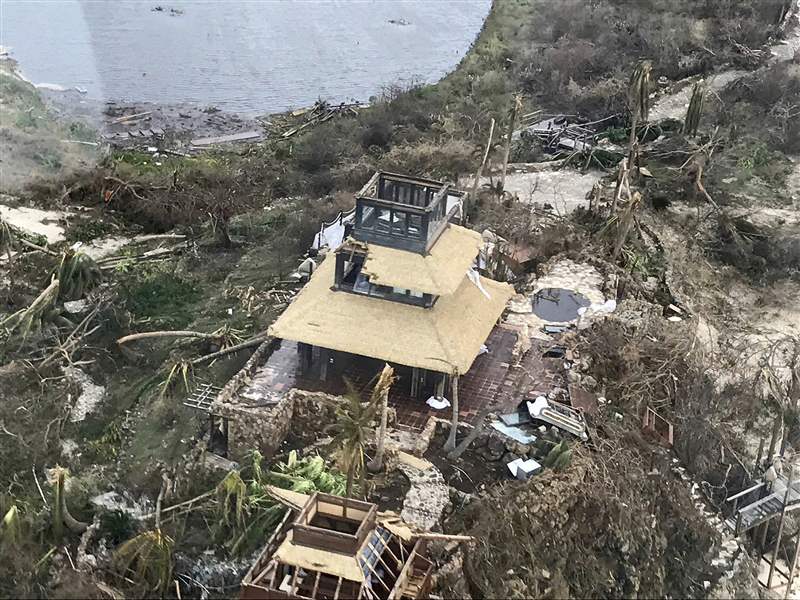
HURRICANE IRMA’S AFTERMATH
Rescue crews race to find victims as Fla. slowly revives
Remote Keys took brunt of wrath
9/13/2017
Hurricane Irma shredded the private island paradise of billionaire Richard Branson on Necker Island, in the British Virgin Islands. The clutch of islands hardest hit were mainly overseas territories of Britain, France, and the Netherlands.
CARIBBEAN BUZZ HELICOPTERS
LOWER MATECUMBE KEY, Fla. — With 25 percent of the homes in the Florida Keys feared destroyed, emergency workers Tuesday rushed to find Hurricane Irma’s victims — dead or alive — and deliver food and water to the stricken island chain.
But because of disrupted phone service and other damage, the full extent of the destruction was still a question mark, more than two days after Irma roared into the Keys with 130 mph winds.
Elsewhere in Florida, life inched closer to normal, with some flights again taking off, many curfews lifted, and major theme parks reopening. Cruise ships that extended their voyages and rode out the storm at sea began returning to port with thousands of passengers.
The number of people without electricity in the steamy late-summer heat fell to 9.5 million — just under half of Florida’s population. Utility officials warned it could take 10 days or more for power to be fully restored. About 110,000 people remained in shelters across Florida.
The number of deaths blamed on Irma in Florida climbed to 12, in addition to four in South Carolina and two in Georgia. At least 37 people were killed in the Caribbean.
“We’ve got a lot of work to do, but everybody’s going to come together,” Florida Gov. Rick Scott said. “We’re going to get this state rebuilt.”
Irma’s rainy remnants pushed through Alabama and Mississippi after drenching Georgia. Flash-flood watches and warnings were issued across the Southeast.
While nearly all of Florida was engulfed by the 400-mile-wide storm, the Keys — home to about 70,000 people — appeared to be the hardest hit. Drinking water and power were cut off, all three of the islands’ hospitals were closed, and the supply of gasoline was extremely limited.
Search-and-rescue teams made their way into the more distant reaches of the Keys, and an aircraft carrier was positioned off Key West to help. Officials said it was not known how many people ignored evacuation orders and stayed behind there.
Federal Emergency Management Agency administrator Brock Long said early estimates suggested that 25 percent of the homes in the Keys were destroyed and 65 percent sustained major damage.
In Islamorada, a trailer park was devastated, the homes ripped apart. A sewagelike stench hung over the place.
Florida has more mobile homes than any other state — about 828,000, said Patti Boerger, spokesman for the Manufactured Housing Institute, a national trade group.
Roughly 600,000 are older models and weren’t built to withstand hurricane-level winds. Only half of the state’s mobile homes, meanwhile, are insured, said Jim Ayotte, executive director of the Florida Manufactured Housing Association.
As Floridians rebuild after Hurricane Irma, housing experts worry they’ll find older mobile homes in widespread disrepair. Newer ones are about as sturdy as regular houses, thanks to the stronger foundations that manufacturers began making after Hurricane Andrew obliterated mobile home parks across South Florida in 1992.
But many went up before the updated housing code took effect in 1994.
But it’s too early to tell the extent of Irma’s damage in Florida.
In the Caribbean, French President Emmanuel Macron vowed to quickly rebuild the islands of the French Caribbean during a visit on Tuesday meant to dispel anger at his government’s response to Hurricane Irma.
The clutch of Caribbean islands hardest hit by the storm were mainly overseas territories belonging to Britain, France, and the Netherlands, whose tens of thousands of residents are European Union citizens. The U.S. Virgin Islands were also hit.
European countries and the United States have sent troops to deliver aid and provide security after the storm.
Britain was forced to reinforce its marines on the British Virgin Islands after more than 100 “very serious” inmates escaped after a prison was breached in the storm, Alan Duncan, Britain’s minister for Europe and the Americas, said on Tuesday.
It was unclear if the prisoners had been captured.
British Foreign Secretary Boris Johnson also traveled on Tuesday to the Caribbean to visit British territories devastated by Irma. Among the hardest hit islands were the British Virgin Islands, Anguilla, Antigua, and Barbuda.
In an assessment of the damage from Irma, Boston-based catastrophe modeling firm AIR Worldwide projected insured losses at $20 billion to $40 billion. That was down from an earlier estimate of up to $65 billion in the United States and the Caribbean and up to $50 billion in the United States alone before Irma’s path and intensity changed.
Other estimates have come in as low as $10 billion, making it perhaps a top 10 U.S. storm but not approaching 2005’s Hurricane Katrina.